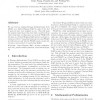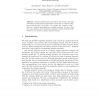IACR
2011
13 years 6 months ago
2011
We describe a systematic framework for using a stream cipher supporting an initialisation vector (IV) to perform various tasks of authentication and authenticated encryption. These...
IJNSEC
2007
14 years 6 months ago
2007
We can view an existing Message Authentication Code (MAC) as a Carter-Wegman MAC in spite of the fact it may not have been designed as one. This will make the analysis easier than...
JUCS
2008
14 years 7 months ago
2008
Abstract: Message Authentication Code (MAC) algorithms can provide cryptographically secure authentication services. One of the most popular algorithms in commercial
ACSAC
2009
IEEE
14 years 11 months ago
2009
IEEE
Reflector attacks are a variant of denial-of-service attacks that use unwitting, legitimate servers to flood a target. The attacker spoofs the target's address in legitimate s...
ISHPC
1999
Springer
14 years 11 months ago
1999
Springer
Computer security is of growing importance in the increasingly networked computing environment.This work examines the issue of high-performance network security, specifically int...
SACRYPT
2001
Springer
14 years 11 months ago
2001
Springer
We present a new message authentication code. It is based on a two trail construction, which underlies the unkeyed hash function RIPEMD-160. It is in comparison with the MDx-MAC ba...
EUROCRYPT
2001
Springer
14 years 11 months ago
2001
Springer
Message integrity from one sender to one receiver is typically achieved by having the two parties share a secret key to compute a Message Authentication Code (MAC). We consider the...
FSE
2003
Springer
15 years 5 days ago
2003
Springer
In this paper, we revisit the security of several message authentication code (MAC) algorithms based on block ciphers, when instantiated with 64-bit block ciphers such as DES. We e...
ISW
2009
Springer
15 years 1 months ago
2009
Springer
We present ShMAC (Shallow MAC), a fixed input length message authentication code that performs most of the computation prior to the availability of the message. Specifically, Sh...
INDOCRYPT
2009
Springer
15 years 1 months ago
2009
Springer
Wireless sensor network (WSN) commonly requires lower level security for public information gathering, whilst body sensor network (BSN) must be secured with strong authenticity to...


